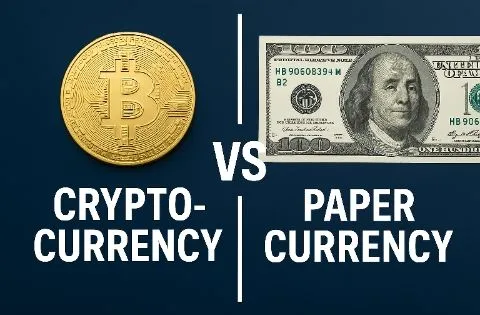
Money is something we use every day. We use it to buy food, pay bills, and save for the future. But have you ever wondered how money is changing?
In the past, money meant coins and paper notes — what we call paper currency. Today, there’s a new type of money rising fast: cryptocurrency. It’s digital, decentralized, and it doesn’t need a bank. So, what makes crypto so different from the money we’ve used for years? Let’s break it down in simple terms.
What is Paper Currency?
Paper currency is the traditional money we know — like the dollar, euro, or naira. It’s printed and controlled by governments and central banks. You can hold it, spend it at stores, or save it in a bank account.
Pros:
- Widely accepted everywhere
- Easy to understand and use
- Protected by government laws
Cons:
- Can be affected by inflation (your money loses value)
- Banks control your access
- Can be slow and expensive to send across borders
What is Cryptocurrency?
Cryptocurrency is digital money. The most well-known example is Bitcoin, but there are thousands of other coins like Ethereum, Solana, and USDT. Crypto runs on blockchain technology, which means no single person or government controls it.
Pros:
- You have full control of your money
- Fast and cheap to send anywhere in the world
- Can grow in value over time (like an investment)
- Transparent — anyone can see the records on the blockchain
Cons:
- Not accepted everywhere yet
- Price can go up and down quickly
- Can be confusing at first
How Are They Different?
| Feature | Paper Currency | Cryptocurrency |
|---|---|---|
| Form | Physical (notes/coins) | Digital only |
| Controlled by | Governments/Banks | Decentralized (users) |
| Transaction speed | Can be slow | Often very fast |
| Privacy | Banks see your data | You stay anonymous |
| Inflation risk | High | Often limited supply |
Which One Is Better?
It really depends on what you need.
If you want simple, everyday money for shopping or paying rent, paper currency still wins for now. But if you want full control of your funds, lower fees, and the potential for higher returns, cryptocurrency is the future.
Many people today are using both — paper money for daily use, and crypto for savings, investment, or sending money abroad.
The Future of Money
As the world goes more digital, cryptocurrency is gaining popularity. Countries are testing CBDCs (central bank digital currencies) — government-backed digital money. At the same time, more stores and online shops are accepting Bitcoin and other coins.
In the next 10 years, we may not have to choose between the two. Paper money and crypto might just work side-by-side — giving people more freedom and options than ever before.
Final Thoughts
Cryptocurrency and paper currency are two sides of the same coin — both have their place. But crypto is showing us a new way to think about money: borderless, digital, and in your control.
The world of money is changing fast. Are you ready for the future?
Bold